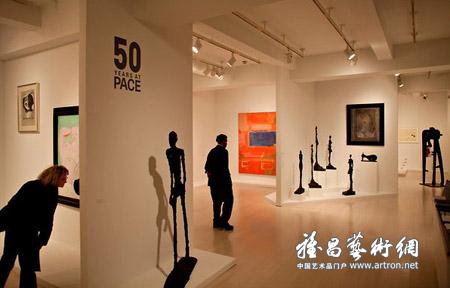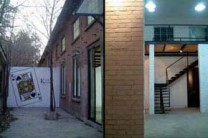The Pace Years: When One Gallery Is Not Enough
2011-04-15 11:31:21

Fifty years ago one of the 800-pound gorillas of today’s New York gallery world was born. Now with four locations in Manhattan and one in Beijing, the Pace Gallery has real estate and a roster of blue chip artists that are eclipsed only by Gagosian Gallery’s global empire, which in addition to three locations in New York, has satellites in Beverly Hills, London, Rome and Athens.
The rise of such mega-galleries has been a source of some consternation for contemporary art followers, many of whom like to imagine art as a spiritual escape from corporate culture. But it is a rare moment these days when there is not a must-see exhibition at Pace or Gagosian.
If “50 Years at Pace,” a multi-site extravaganza honoring a half-century in the art business, is not in the essential viewing category, it is partly because it loses points for vanity. The spectacle of a commercial enterprise so immodestly celebrating itself is off-putting and intellectually discomfiting. As an overcrowded sampler of the art it has shown, the artists it has represented and the exhibitions it has produced over the course of its lifetime, “50 Years” feels more like a one-gallery art fair.
And yet the three Pace galleries where the anniversary shows are still on view are loaded with wonderful individual works. And with an overall scheme that has classic Modernist works uptown, examples of late Modernism and Pop Art on West 25th Street and works of conceptually driven Postmodernism on West 22nd Street, the exhibitions collectively would make an excellent introduction to 20th-century art for the uninitiated.
(A fourth show that included contemporary works by James Siena, Tim Hawkinson and Tara Donovan, at 510 West 25th Street — the former site of Bortolami Gallery recently taken over by Pace — closed on Saturday.)
The uptown show revisits a series of museum-quality exhibitions mounted by Pace in the past. There you will find a group of Alberto Giacometti’s crusty, emaciated, cast-bronze figures and another set of cast and welded sculptures by Picasso that is notable for its stylistic diversity. An airy, almost completely abstract structure of steel rods and a chunky bronze primate whose face is cast from a model car testify to an nearly inhuman range of aesthetic inventiveness.
Several of those past exhibitions were based on affinities between artists of different times and places. The side-by-side hanging of one of Willem de Kooning’s ferociously expressionist women and a painting of a flattened woman by Jean Dubuffet that looks as if it was scrawled into dirt by a young boy demonstrates a shared, trans-Atlantic interest in primordial femininity. Elsewhere a gorgeous painting of floating, fuzzy-edged rectangles in red and blue by Mark Rothko is paired with a similarly luminous landscape by Pierre Bonnard, and a vividly optical grid painting in blues and greens by Ad Reinhardt converses with grid paintings in black, white and primary hues by Piet Mondrian.
Meanwhile, down in Chelsea, late black paintings by Rothko and Reinhardt and all-black, wooden constructions by Louise Nevelson occupy one part of the gallery, along with a velvety blue zip painting by Barnett Newman and a bright orange monochrome by Robert Ryman. A big, lush pattern painting based on esoteric researches by Alfred Jensen pulses with electric intensity across the room.
A separate space presents more playfully disposed works by Pop artists and their forerunners. Here you find that deceptively modest piece of mischief making, Robert Rauschenberg’s “Erased de Kooning”: a small drawing by de Kooning, the Abstract Expressionist, that Rauschenberg, the proto-Pop artist, abraded to a ghost of itself. Also on hand are Roy Lichtenstein’s cartoon painting of a beaming girl holding a beach ball; a giant club sandwich made of stuffed, colored vinyl by Claes Oldenburg; a canvas by Andy Warhol bearing 50 copies of an image of Marilyn Monroe, half in color, half in black and gray; and “Three Flags” by Jasper Johns, which has small, medium and large painted copies of the United States flag in an enigmatic, deadpan stack. A sweet, simplified picture by Alex Katz of himself, his wife and their infant son strolling along a tree-lined road is a suave, nostalgic dream of naturalistic painting.
Finally, on West 22nd Street, we enter the world of today, in which traditional genres of painting and sculpture no longer determine the field of ambition for forward-thinking artists. Sometime in the ’60s, it seems, subjective consciousness replaced abstract form as the main object of exploration.
In a small dark space two magical works by James Turrell confound visual perception. They appear to be flat, translucent panels lighted from behind; but try to touch one, and your hand passes into immaterial space. A room clad inside and out with mirrored panels by Lucas Samaras creates a vertiginous, kaleidoscopic interior of reflections extending into virtual infinity. These might be metaphors about the mind and its limits, which have come to seem far more expansive than most people imagined back in the dark ages of the 1950s.
A cube of smoky glass by Larry Bell; a hovering circle of white plastic by Robert Irwin; a stack of purple boxes exuding an orange glow from within by Donald Judd: perceptually fine-tuned works like these anticipate a cool future like that of “2001: A Space Odyssey,” which, alas, has yet to arrive. Artifacts of an age of visionary rationalism, they now seem more fantastic than ever.
One of the most strangely disconcerting works here is Chuck Close’s “Fanny,” a giant, Photorealistic head of a corpulent elderly woman, rendered entirely by the application of gray fingerprints on a snowy white ground. An archetypal Great Mother, she gazes out over the carnival of youthful hubris with an ancient, benevolent wisdom, as if to remind us that being human is all we have, however urgently we may strive to exceed our ultimate biological destinies.
“50 Years at Pace” continues through Saturday at Pace Gallery locations: 32 East 57th Street, Manhattan, and 534 West 25th Street and 545 West 22nd Street, Chelsea; (212) 421-3292, thepacegallery.com.

 黄琦
黄琦 测试用艺术
测试用艺术
